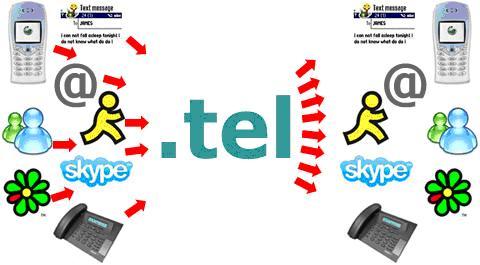Deep Interview about .tel domains with Benjamin Blumenthal from Telnic
.tel | Interviews 26 de marzo de 2007
Domisfera wanted to know more about the real state of .tel domains, so asked for an interview with Benjamin Blumenthal, Director of Marketing of Telnic. This is the result, if they are enough and relevant questions and comments from the readers, Domisfera will make a second interview.

(1) [Domisfera.com] Could you tell us more about the history of .tel and when was it approved by ICANN?
[Benjamin Blumenthal] Telnic initially submitted an application to ICANN in 2000 for the .tel Top Level Domain (TLD). At that time, we believed that the internet and telephony industries would be converging quickly and that a top level domain would be needed to organize this space. With hindsight, our intuition has proven to be correct.
ICANN finally approved Telnic’s second application submitted in 2004. The final agreement was signed on May 30th 2006.
(2) Can you explain in more detail how the .tel works?
The .tel will allow domain owners to publish and update in real time their contact information directly in the DNS.
This will allow them to decide how their friends, colleagues and clients should reach them, including but not limited to: VoIP, conventional telephony (fixed or wireless), email, SMS, Skype, AIM and many more.
Here’s how it could work…
Imagine you want to call your friend Juan Sanchez, who is stored in your phone directory as JuanSanchez.tel. Your phone or computer connects to JuanSanchez.tel and receives a response with all the contact options that Juan has decided to offer you at that time. This might include Phone, Mobile, Skype, Email, ICQ, etc…
You decide which of these contact methods you want to use. If you select Skype, your device (if capable) will launch the Skype application and will send out a request for skype: JuanSanchez (his skype ID) and connect you.
All of this is completely seamless. You don’t have to memorize or store all of the numerous contact options of each of your friends and associates. All you need is YourFriend.tel and you’re set.
This, of course, is just the basic concept behind the .tel. We have developed a set of exciting applications for desktop computers and mobile phones that will significantly enhance the user experience and enable advanced features.
The .tel is equally useful for businesses. Using the .tel TLD, businesses can securely publish and manage their contact information in real time, controlling how and where customers can communicate with them. Businesses can use the .tel to extend their brands, reach mobile customers and better handle customer requests.


You could call Hertz.tel and select Europe, United Kingdom and Customer Service from the menu. Then you could select telephone and speak directly to a Hertz representative in your area to make a car rental reservation. All you need is the CompanyName.tel and you are ready to go.
(3) What is the difference between .tel and the other top level domains?
With the exception of .tel, all the other TLDs point to websites.
For example: IBM.com, Telnic.org and Google.es all direct the viewer to a website with online content. The new .mobi domain also routes people to websites that are appropriately formatted for small screens.
By contrast, the .tel uses its top level domain and the DNS (Domain Name System) in an entirely new way and for an entirely new purpose. Instead of routing people to online website to view content, the .tel points directly to people and businesses’ contact information so that you can immediately initiate communication.
Unlike all the other TLDs that use the DNS to point to “machines” or computers that host websites, the .tel points directly to phone numbers, VoIP IDs, email addresses and many other means of communication. This makes .tel very different from all other top level domains.
(4) When will you launch the .tel? What will the registration policies be? Will there be reserved domains? Will you implement the "first-come first-served" policy?
We are discussing the timing of launch with the community as we are aware of the need to avoid conflict with the launch of other TLDs such as .asia. Our official launch date will be announced shortly.
Policies are being finalized and will be available in due course. We are contractually obliged to withhold certain names, however there will not be a premium names auction list as was the case with .mobi.
We will implement the “first-come first-served” policy, as this is standard in the industry and ensures fairness.
(5) How much will a .tel domain cost?
During the General Availability phase, we are expecting the price for a .tel domain to be in line with other popular domain names.
(6) Will multiple-year registrations be possible?
Yes.
(7) Will the .tel support IDN domains?
Yes, .tel will support Internationalized Domain Names (IDNs) but not initially. Technically, our systems are ready. We are working with the other registries and ICANN to find common policies on this issue.
(8) What will happen when a company or person wants to buy a .tel domain that has already been registered by another company or person? What is the procedure and who will arbitrate?
A company or person who wishes to register a name that has already been registered could register a variation on that domain name.
They could also offer to buy the domain name from the existing owner. In the event of a dispute concerning a owner’s entitlement to a .tel domain name, Telnic is subject to the UDRP procedure as per other gTLDs. This policy is independently arbitrated by WIPO, NAF and other bodies.
(9) Do you believe that as the companies in the adult industry will extend their brands using this extension? Perhaps with the 800 (hot) lines?
Everyone is welcome to register a .tel domain name provided they abide by the terms of our Acceptable Use Policy.
(10) How many Registrars or Resellers have signed up to sell .tel domains? Any in Spain?
Telnic is in touch with all major registrars worldwide including those in Spain and all have indicated their interest and support for this innovative top level domain.
(11) Do you believe that .tel will be a revolution in the communications space?
When you use the internet, you use text to reach websites because text is much easier to remember than numbers. You type www.CNN.com when you want to go to CNN and read the news. You do not type in CNN’s long and complicated IP address (64.236.16.84). The success of the world wide web has been largely due to the ability to use easy-to-remember brand names instead of numbers.
Today, the .tel proposes to do the same thing with phone numbers. Why should someone have to remember all your points of contact, including phone numbers and fax numbers for you, when they could simply remember YourName.tel or YourCompany.tel? This will clearly change the landscape of our industry.
(12) DotMobi has shown that it’s possible to launch an sTLD having a rapid penetration in the market. Do you believe that with a good marketing department everything is possible? Are you going to invest more than .mobi? Have you defined your marketing strategy yet?
A good idea and good marketing goes a long way. We strongly believe that the most effective marketing strategy is word of mouth about the quality of the product or service you offer your customer. We believe that once people discover the benefits of the .tel and the cool features of the free applications that support their .tel domain, they will use the .tel to communicate and this usage will drive further registrations.
With regards to .mobi, as we mentioned before, the .tel and .mobi are very different. The .mobi is about small screen websites. The .tel is about reaching and communicating with people and businesses. Therefore, our marketing strategy will obviously be different from the strategy deployed by .mobi because we are targeting a much larger market than small screen website content providers.
(13) Do you think that traditional phone companies such as Vodafone, Telefónica, Orange and TIM see in the .tel extension as a competitor or an ally? Will you sign agreements with them? Or will you sign agreements with VoIP companies such as VoipBuster, Skype and PeopleCall?
The entire focus of .tel is on people and businesses and how they communicate with one another. The .tel concept is not a replacement for a phone service, it just makes it easier for people to use these services. We believe that there is a strong synergy with .tel for every communications service provider and its customers. This is true whether a person uses a mobile phone, a home phone, or a VoIP device, or a PC.
The .tel is a neutral platform that integrates old means of communication with new ones such as VoIP. Furthermore, .tel is not a telephone service provider. Therefore, we are not and will never be in competition with Vodaphone, Telefonica, TIM, Skype, VoIPBuster or others. On the contrary, we believe that this neutral platform will offer these operators, whether fixed line, mobile or VoIP, great opportunities to provide their customers with new and value added services.


















Han dejado 3 comentarios...
.tel - explained « GPM Group
26 de marzo de 2007 at 10:13
[…] The interview explains what sets .tel apart from other tlds. […]
James Pearce
27 de marzo de 2007 at 11:23
This is an article that clearly articulates the .tel proposition. Over at dotMobi, we’ve also written about what sets it apart:
http://dotmobi.typepad.com/dotmobi/2007/03/tel_and_mobi_le.html
I would just suggest one small correction to your article. You say «The .mobi is about small screen websites». That’s not entirely true.
The .mobi domain is about content and services that are designed to a) reliably work on a mobile handset, and b) be relevant to a user in the mobile context – that is, out and about with a portable device.
Sure, most handsets have small screens, but many do not. And many have highly capable browsers. But mobile-relevant services are not only those which have bijou markup.
Ana
22 de abril de 2007 at 20:42
Could you please tell me when the .tel is for sale and where I can purchase them from? Thanks.